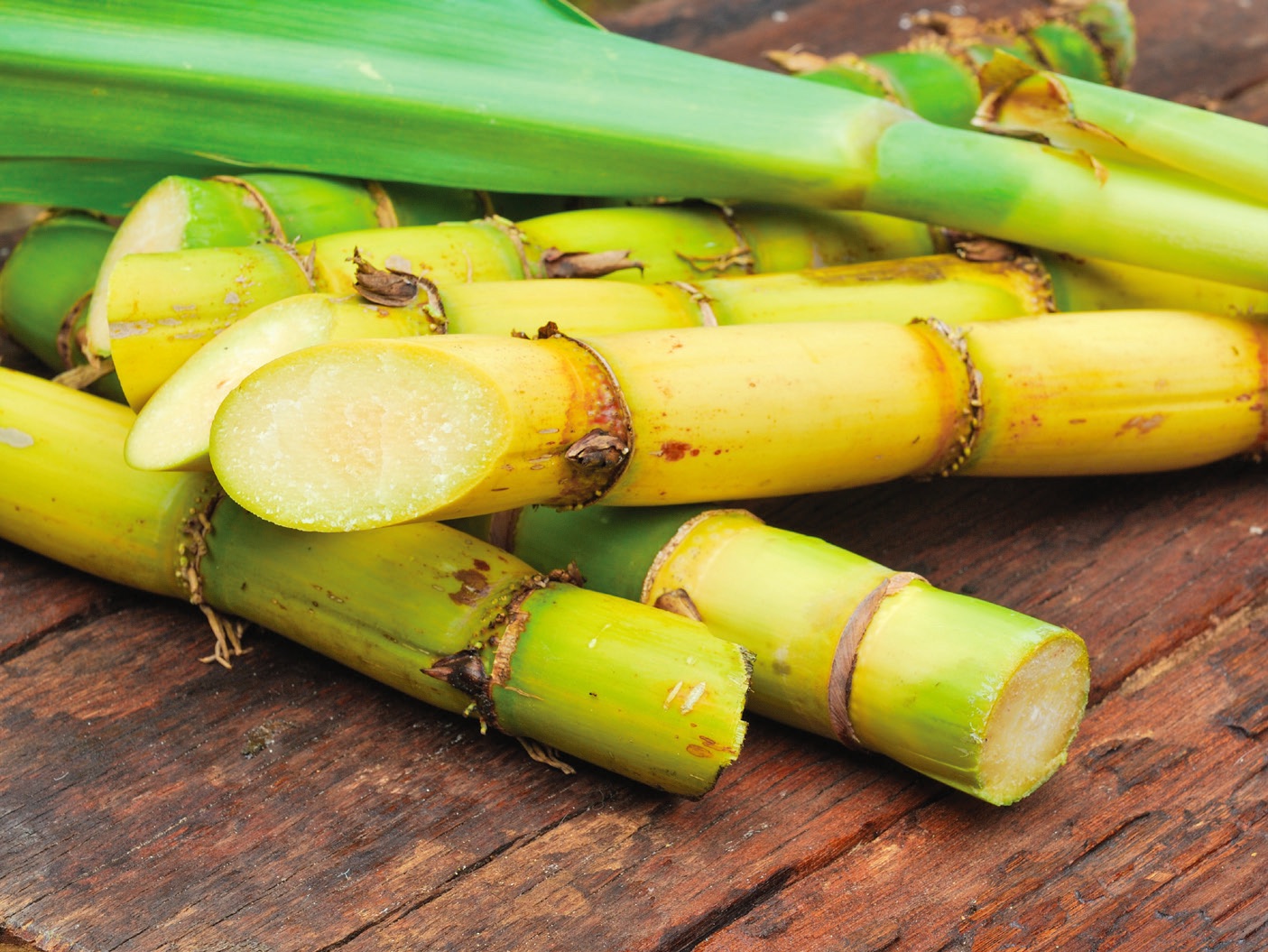KEY CONCEPTS
•
Energy cane, a crop not directly linked to the food chain, has the capability of being used in the manufacture of biodiesel and potentially more value-added applications such as lubricants.
•
A new approach for processing energy cane involved the use of hydrothermal pre-treatment and disk milling.
•
Cryogenic grinding was utilized in a follow-up study to minimize the formation of inhibitors that can reduce the effectiveness of fermentation microorganisms.
The ongoing movement toward sustainability has led to the growing use of environmentally acceptable raw materials in the development of fuels and lubricants. Examples include the growing use of biodiesel, which is a fatty methyl ester derived from crops such as soybean, and the preparation of sustainable aviation fuel.
In a previous TLT article,
1 researchers used the intermediate isophorone, a cyclohexene derivative derived from natural sugars, in the preparation of a sustainable component that exhibits comparable characteristics to the currently used, petroleum-based aviation fuel known as Jet-A. Isophorone is prepared directly from the common solvent acetone and used in a photochemical, cycloaddition reaction to form the cyclobutane derivative. When this renewably sourced derivative is blended at a 30% treat rate with Jet-A, a 3.8% improvement in energy density was realized.
The concern with using soybean oil as one of the main raw materials to manufacture biodiesel is that soybean oil is widely used in food applications. In effect, biodiesel is competing with food-related applications. A better option is to identify a crop that is not directly linked to the food chain but has the capability of being used to manufacture biodiesel.
Such a crop is known as energy cane. Vijay Singh, Founder professor in the department of agricultural and biological engineering at the University of Illinois at Urbana-Champaign in Urbana, Ill., says, “Energy cane is a non-food energy crop that is closely related to sugar cane in terms of genetics. The big difference between energy cane and sugar cane is that the former has a much higher level of fiber than sucrose. The energy cane plant can be engineered to convert sucrose into vegetable oil.”
Energy cane is a high-yielding crop (55-85 metric tons per hectare) that can be designed to grow in colder temperature climates and can require lower levels of fertilizer and water. The crop also is more durable than sugar cane, requiring less frequent replantation.
Singh says, “We feel that these characteristics enable energy cane to be a more sustainable crop than other bioenergy crops. Energy cane is capable of absorbing more carbon than it releases. Another benefit is that we can tailor the composition of the oil produced by a specific energy cane so that it can be used in more value-added applications such as lubricants.”
 Energy cane is a non-food energy crop that is closely related to sugar cane. The big difference between energy cane and sugar cane is that the former has a much higher level of fiber than sucrose.
Energy cane is a non-food energy crop that is closely related to sugar cane. The big difference between energy cane and sugar cane is that the former has a much higher level of fiber than sucrose.
Singh says, “Vegetable oil can be used for making fuels and industrial products (such as lubricants), and fiber can be converted into cellulosic sugars that eventually will lead to bioethanol after fermentation. A second alternative pathway is to burn the fiber in boilers as fuel to generate electricity, which is more profitable at the moment.”
Singh and his colleagues (
see Figure 3) have published four papers detailing the progress made in processing energy cane into biodiesel and cellulosic sugars.
 Figure 3. These four researchers are tailoring the composition of energy cane so that this crop can produce oil usable in value-added applications such as lubricants. Figure courtesy of the University of Illinois.
Hydrothermal pretreatment/disk milling
Figure 3. These four researchers are tailoring the composition of energy cane so that this crop can produce oil usable in value-added applications such as lubricants. Figure courtesy of the University of Illinois.
Hydrothermal pretreatment/disk milling
The challenge in processing energy cane is to develop a process for isolating and breaking down biomass, which contains a complex matrix of cellulose, hemicellulose and lignin. Prior techniques have included the use of dilute acid and dilute ammonia. Singh says, “Use of chemical pretreatment is not desirable because it can cause changes in the lipid profile and affects the quality of oil recovered from engineered energy cane.”
To move to a more environmentally friendly approach, the researchers subjected energy cane to a hydrothermal pretreatment process followed by disk milling.
2 Energy cane was hydrolyzed with water at temperatures of 160, 180 and 200 C for residence times of five, 10 and 15 minutes. Water is considered to be a very dilute acid due to the increased hydronium ion concentration found under the high temperatures used.
Disk milling follows pretreatment in order to further process the biomass. Singh says, “Our objective in using disk milling is to physically breakdown the fiber making the resulting fiber more receptive to further enzymatic processing in, for example, using fermentation to convert cellulosic sugars to bioethanol.”
One concern that was found in the first study was that components known as inhibitors form readily above 170 C and can reduce the effectiveness of fermentation microorganisms in subsequent processing steps. Examples of inhibitors include formic acid, acetic acid, furfural and phenol derivatives.
The researchers decided to reduce the operating temperature of the hydrothermal pretreatment to temperatures below 170 C followed by cryogenic grinding. Singh says, “The results in a second study
3 show promise in reducing inhibitor concentration and improving recovery of sugars.”
As the research program to develop specific types of energy cane moves forward, the researchers realized that a more effective analysis of the oil produced will be needed to screen the hundreds of specific crop candidates. Singh says, “We developed a 1H nuclear magnetic resonance method that very quickly shows how much oil is present in the original crop or in the processed fractions. This technique is very effective and helps determine the oil concentration in the tissues of the plant (leaves and stem). In contrast, the established solvent extraction method is exceptionally time consuming, relies on high levels of chemicals and usually is followed by chromatography, which also is a slow process.”
A third article
4 detailed results from the NMR work.
The fourth article
5 reports the findings from a techno-economic feasibility study that evaluated the conversion of energy cane to biodiesel (from TAGs) and ethanol (from fermentation of sugars). Both scenarios were found to be profitable and self-sustainable.
Singh says, “Our goal is to develop an energy cane crop that will only produce oil (TAGs) so we can maximize the production of biodiesel.” Additional information can be obtained by contacting Singh at
vsingh@illinois.edu.
REFERENCES
1.
Canter, N. (2020), “ New approach for sustainable aviation fuel,” TLT,
76 (5), pp. 24-25. Available
here.
2.
Juneja, A., Kumar, D., Singh, V., Yadvika and Singh, V. (2020), “Chemical free two-step hydrothermal pretreatment to improve sugar yields from energy cane,”
Energies, 13 (21), 5805.
3.
Maitra, S. and Singh, V. (2021), “Balancing sugar recovery and inhibitor generation during energycane processing: Coupling cryogenic grinding with hydrothermal pretreatment at low temperatures,”
Bioresource Technology, 321, 124424.
4.
Maitra, S., Dien, B., Long, S. and Singh, V. (2021), “Development and validation of time-domain 1H-NMR relaxometry correlation for high-throughput phenotyping method for lipid contents of lignocellulosic feedstocks,”
GCB Bioenergy, 13 (7), pp. 1179-1190.
5.
Kumar, D., Long, S., Arora, A. and Singh, V. (2021), “Techno-economic feasibility analysis of engineered energycane-based biorefinery co-producing biodiesel and ethanol,”
GCB Bioenergy, 13 (9), pp. 1498-1514.